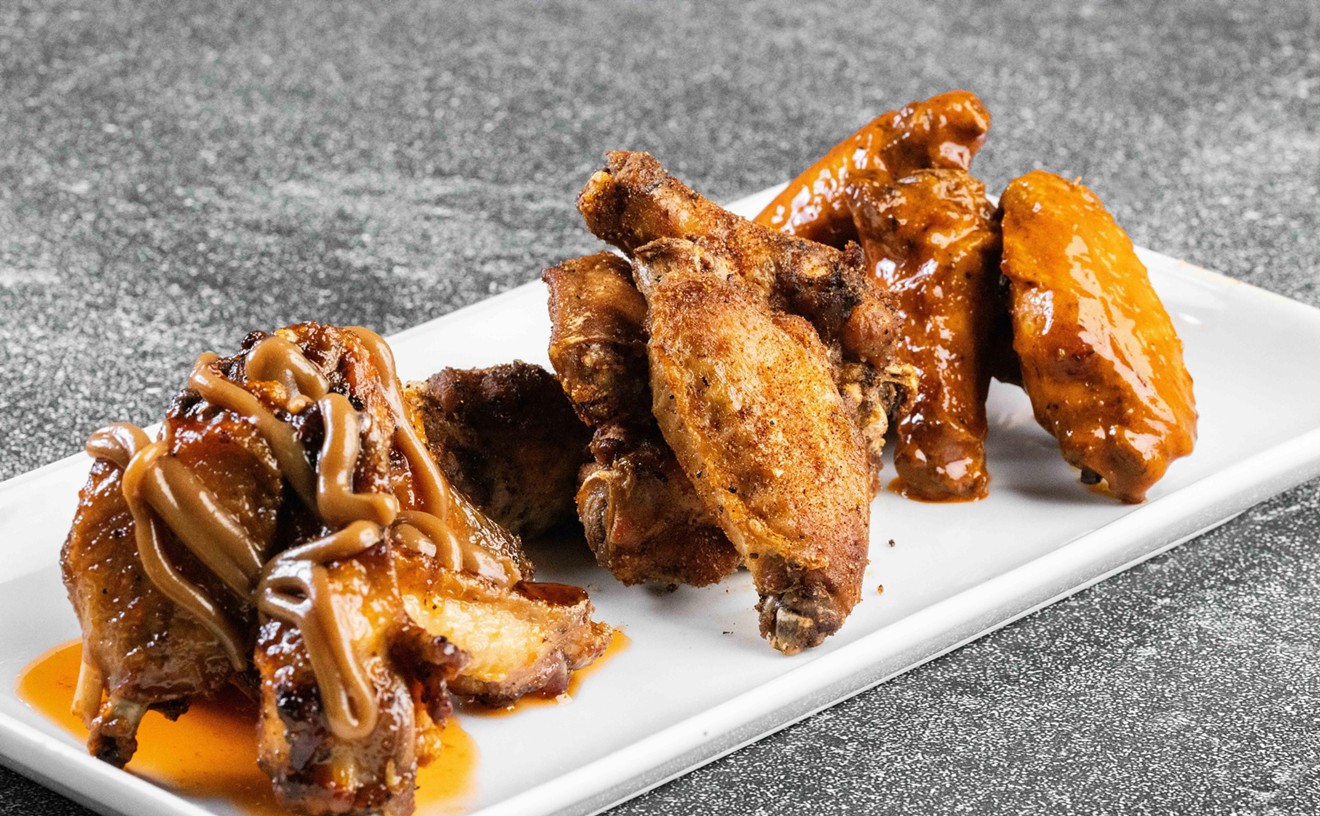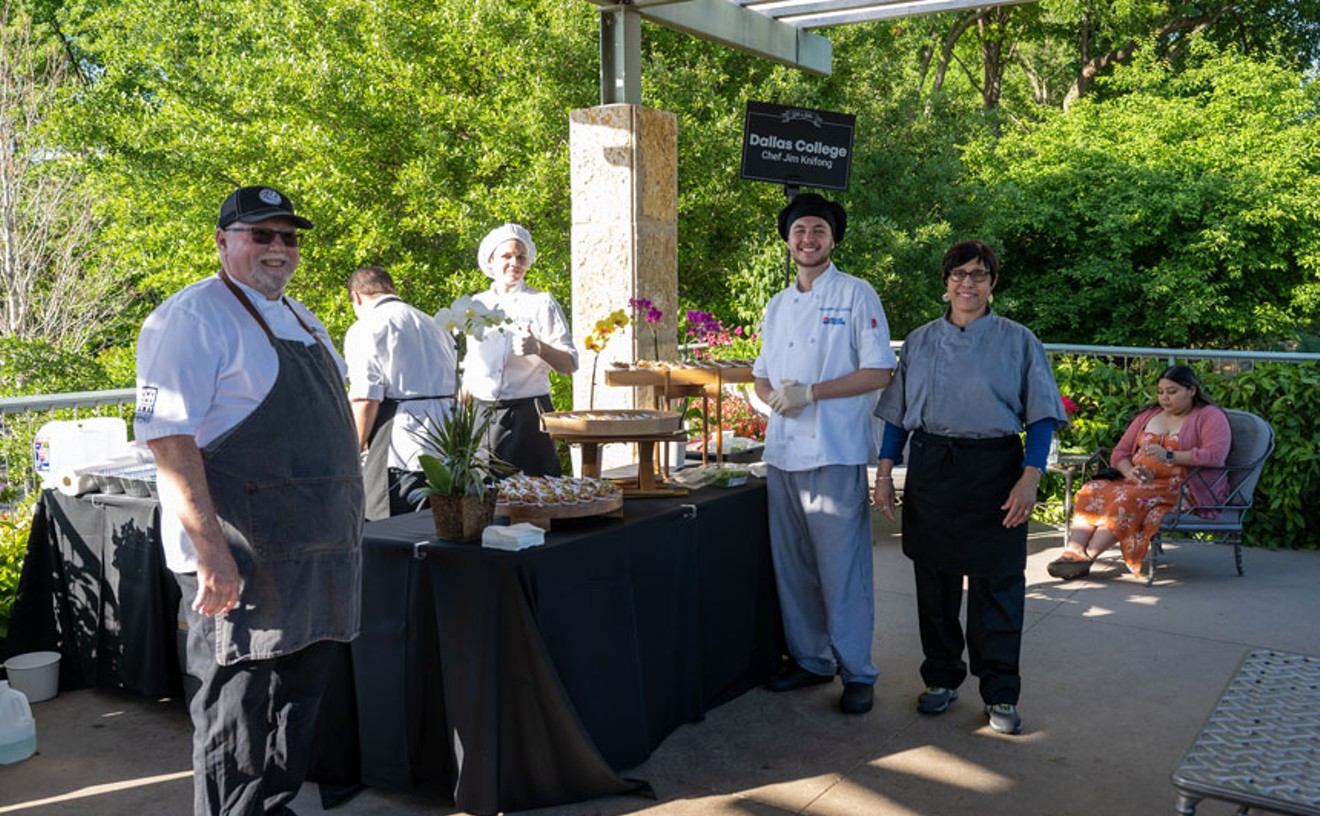Take the ahi tower, which resembles a grain silo. This demanded an invention. The dish is a structure to behold: tall, symmetrical, colorful and crowned with fuzzy strands of seaweed and flecks of wheat gluten. Look closely and you'll notice the top story of shredded tuna isn't as perfectly proportioned as the segment of motley fake crab strands below, or the section of compacted avocado beneath. Bringing up the bottom is a layer of rice. It's built in the center of a plate beaded with wasabi cream and a "secret sauce" soaking little clumps of caviar in three variations: wasabi, habanera and black. No, "built" isn't the right word. "Pumped" is. Enter the invention.
It looks like a plumbing tool or a medical device. To create it, Little Katana chefs slice the top and bottom from a plastic squeeze bottle, leaving a simple tube. Ingredients are assembled in layers in the tube and then compressed. The composition is then pushed from the tube with a plunger (a narrower, intact squeeze bottle), excreting the tower from what is essentially a giant syringe.
You won't be permitted to gaze at it for long. The instant it's placed on the sushi bar, a server grips a fork, retrieves the plate and smashes the tower into the secret sauce and the caviar globules, leveling everything into a rummage of glorious chunky color rarely experienced without the aid of Jägermeister. Such destruction is the child of necessity. Pecking at a tower of raw fish and fake crab is gauche. Plus, if left assembled, there would be no way to merge the tower's complex of seafood and goops. It must come down. A mess must be made.
Sifting through the rubble (use a fork instead of chopsticks) is riveting: You wonder how this hash of flavors and textures harmonizes instead of clashes, as signature sushi rolls often do.
The ahi tower syringe is just the tip of the inventiveness berg: Little Katana also custom built a grill designed to survive the heat generated by the imported Korean oak charcoal the kitchen uses. The heat is so intense that it blew the bottoms out of the cast iron grills the cooks tested. Enter the double-walled stainless steel grill. The process of taming Korean oak charcoal actually delayed the opening of Little Katana for close to a year after the space (in what was once Torrefazione Italia) was leased, as chefs and management attempted to solve the bottom-blowing problem. On this Korean inferno, chefs sear steaks for just a few seconds on each side and then remove them from direct heat to slow-cook them for a few minutes.
Results are mixed. A ginger-garlic marinated flank steak, cut into slices draped around a mound of mashed potatoes and scallions, is tenderly lush with a pronounced layer of sweetness. But a rib eye was dry—cooked far beyond the ordered medium rare—and riddled with gristle. Next to the meat are a few asparagus tips that apparently met with Korean charcoal calamity; they were singed, dry and woody.
Little Katana is a unique commixture of Japanese, Korean and Thai cuisines and influences. This mutation isn't unusual, but Little Katana composes it in distinct ways. Most restaurants of this ilk skimp or otherwise stumble on the sushi. Here, it's mostly deluxe.
Except for this:
Us: "You got any uni today?"
Them: "No. We haven't been selling a lot of it."
Us: "Not selling uni? In Uptown?"
Them: "We only get it periodically. Most of the time we get it in, the owner eats most of it."
That uni eater is Odes Kim. Kim operates Members Building Maintenance, a janitorial services firm that scrubs and buffs large commercial buildings, including part of DFW International Airport. He recently opened Stone Horse Bistro, an upscale Asian fusion restaurant in Richardson. All this nosh-ery was mothered from a tiny seed: the original Little Katana sushi bar next to Macy's in the Galleria, a restaurant seemingly no larger than a mop closet.
But from this little seed comes big sushi bliss. A simple sliver of mackerel—with a patch of spotted silvery skin left intact near one end—is simply the best piece of the species I remember experiencing. Tender. Lacy. Briny. Brisk. Octopus is chewy and shaved thin into delicacy. Cool, supple squid has a dot of diced ginger on top for added bite. Tobiko is fresh and fluffy, the tiny eggs exploding with clean bursts. Spicy tuna roll is moist and loosely packed, permitting flavors to exhale effortlessly.
A hot stone bowl is filled with moist fried rice and topped with an egg blanket dribbled with pepper sauce. The bowl is locked in a wooden slot and delivered on a plate. Resting on the bowl's rim is a long ceramic tray spread with raw vegetables: green pepper, onion, carrot, bean sprouts, mushrooms and so on. Plus slices of lime. Scoop the contents out of the stone bowl with the enclosed wooden spoons. Spread over the plate. Apply vegetables liberally. Notice how uncommonly delicious the egg is, loose and thin, yet supple, like organza or some other favored lingerie substance. Observe how fluffy and separate the rice is. Note how the crisp vegetables invigorate the rice and egg. Squeeze some lime on that.
Miso sea bass is exquisitely sweet and rich, sections slipping cleanly from the mother hunk.
As much as Little Katana belts homers with squeeze-bottle syringes and sea bass, it flubs simple pops with the service. Case study: the French-cut pork chop. We ordered one. Our server returned several minutes later to tell us there was none. He suggested the rib eye. We complied. Both the rib eye and pork chop showed up on our bill. Drink orders were taken and then abandoned. You could see the cluster of bottles and beer glasses languishing on the bar. "Where's my beer?" Our server captured the beer from the bar and left the others. "Where's my sake?"
Little Katana boasts one of the largest sake selections in Dallas, ringing in at 45—44 of them cold. Heat, as you may well know, unravels sake's nuances. Heat, as you also may know, cuts winter bone chill. Cold sake is served in a potbellied glass bottle with a blue glass pouch blown into the side. It's filled with ice, making each sip an aesthetic ritual, heightening those nuances.
Heat is essential to the Asian bouillabaisse in many ways. As previously noted, the soup is bright orange and spicy. This is on account of sriracha, the potent Thai pepper sauce. Four fried soba noodles protrude from the broth that holds onion, potato, celery, shrimp, scallops and chunks of fish. The broth ends of the noodles are flaccid; the long ends crisp and nutty. The broth is searing and vibrant, bludgeoning this Mediterranean stew from Provence with Asian twists.
Little Katana finishes with another invention: mango cheesecake. This is noteworthy because it contrasts so eloquently with the ahi tower. While the former is a clean, proportioned tower that becomes a mess, the cheesecake is a mess that becomes a tower. Chunks of mango, cheesecake rubble and mango sauce are haphazardly dumped into a sundae glass and topped with whipped cream. This tower is equally delicious. Now if they could only invent something to make towers out of those service messes. 4527 Travis St., 214-443-9600. Open 11 a.m.-2:30 p.m. Monday-Saturday, 5 p.m.-10 p.m. Monday-Thursday and 5 p.m.-11 p.m. Friday-Saturday. $$$










